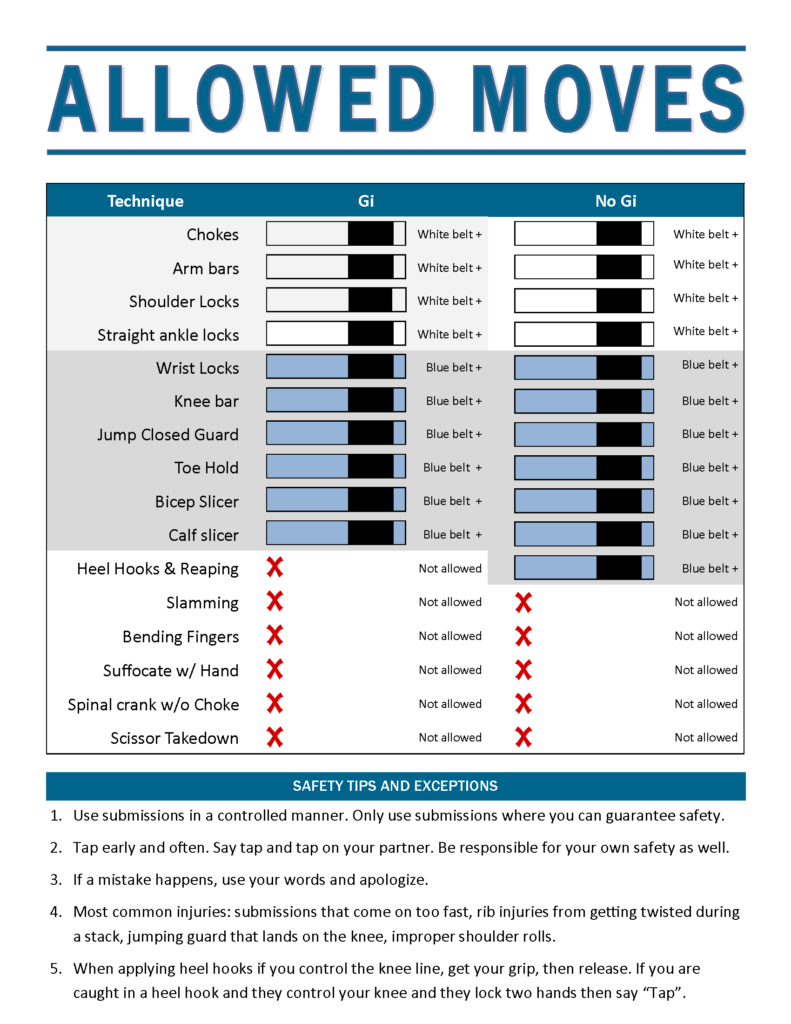General Etiquette
- Come with a positive attitude.
- Show respect by bowing on and off the mats.
- Greet your fellow classmates.
- Address black belt instructors as Professor and other instructors as Coach.
- Be on time to class, but late is better than not being here.
- Refrain from coaching your children from the benches.
- Avoid talking that is disruptive or disrespectful.
- Place water bottles and gear bags on cubbies and shelves.
- Take care of your training partners and be conscious of differences in size and strength.
- Avoid crashing into other groups, especially higher belts.
- Shake hands and bump fists before every roll
- Give a genuine compliment after the roll.
- Believe in yourself and your teammates.
Hygiene
- Bring a clean uniform and mask to every class. Wash it after use.
- Wear a rash guard or athletic shirt under your uniform.
- Keep your fingernails and toenails short and trim.
- Remove all jewelry before class.
- Remove all footwear before stepping on the mat and use the foot washing station.
- Wear sandals when using the restroom.
- If you are cut or scraped, use Band-Aids and tape.
- Disinfect any blood on the mats or let staff know.
- Shower after every class. We recommend a body wash of Defense Soap or Selsun Blue.
- If you have a cold or flu or COVID symptoms in the past 10 days, please stay at home.
- If you have a skin infection or rash, stay off the mats.

We have posters like this around the academy to make it easier to know moves are allowed and some safety tips as well. BJJ isn’t a free for all where you are allowed to do any move you saw on YouTube on an unsuspecting partner.
The safety tips listed above include:
- Use submissions in a controlled manner. Don’t use submissions where you can’t guarantee your partner’s safety.
- Tap early and often. Be responsible for your own safety.
- If a mistake happens, use your words and apologize.
- Most common injuries: submissions that come on too fast, rib injuries from getting twisted during a stack, jumping guard that lands on the knee, improper shoulder rolls.
- When applying heel hooks if you control the knee line, get your grip, then release. If you are caught in a heel hook and they control your knee and lock two hands then say Tap. Heel hooks are for No-Gi only.
Note that these are the allowed moves for adults in the academy and different tournaments will differ.
Why can I only heel hook or reap No-gi?
For one the extra friction with the pants on makes it really difficult to slip clear the knee line, heel slip or other defenses for heel hooks, so you are pretty much just stuck with hand-fighting and standing up. Secondly there are basically no tournaments that allow this, so I am not sure what you imaginary scenario you are preparing for. That being said, if you want to heel hook someone in the gi, you could ask “do you want to play with heel hooks in the gi?”, they will probably look at you funny, but if they agree, cool you are both adults.
Why can't I do a scissor takedown in training?
There is a reason that the scissor takedown used to be allowed in wrestling and judo, but now it isn’t. When sloppily applied there is a high chance of a tib/fib break or knee injury if you don’t jump high enough or get pushed down. This technique had one of the famous injuries when Japanese Olympic bronze medalist Endo injured current world champion Yasuhiro Yamashita in the 1980 All Japan Championships. This injury would give Endo the spot on the Olympic team calling into question whether he injured Yamashita on purpose. I have seen a tib/fib break from this first hand and it isn’t something that I want to see again.
Why are blue belts allowed to do kneebars and toe holds when they are banned by the IBJJF until brown belt?
We want our students acclimated to attacking and defending these moves before they have to see them in competition. Generally the risk of injury is pretty low with them.
